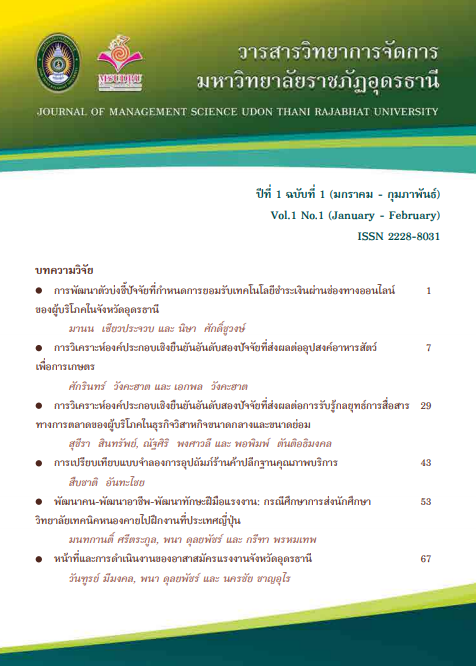DEVELOPING AND IDENTIFYING INDICATORS OF FACTORS DETERMINING THE GENERAL ACCEPTANCE OF ONLINE PAYMENT TECHNOLOGY FOR CONSUMERS IN UDON THANI PROVINCE, THAILAND
Main Article Content
Abstract
This research was carried out with objectives as the following: 1) Development of indicators determining the general acceptance of online payment technology for consumers in Udon Thani province 2) Evaluate construct validity of model/prototype measuring indicators determining the general acceptance of only payment technology for consumers in Udon Thani province by means of second-order confirmatory factor analysis technique. The sample were 500 consumers in Udon Thani province with the online payment transaction behavior, The instrument used in conducting research was the factor-analyzing pattern which determined the acceptance of such technology, through analysis of database by the method of exploratory fact analysis and second-order confirmatory factor analysis. Research findings suggested that indicators determining the general acceptance of online payment technology for consumers in Udon Thani province consisted of 3 parts which were perceived risk, perceived ease of use and perceived usefulness. For more elaboration, perceived risk comprised indictors for risk identification of person information, risk in being ripped off, risk in making mistakes and risk in comparison to cash payment method. For perceived ease of use, it comprised indicators of learning difficulty, implementation difficulty, complexity of implementing procedure and specializing in performing task. Lastly, perceived usefulness composed of speed indictors, facilitation, time-saving and value-adding aspects.
Article Details

This work is licensed under a Creative Commons Attribution-NonCommercial-NoDerivatives 4.0 International License.
บทความที่ได้รับการตีพิมพ์เป็นลิขสิทธิ์ของคณะวิทยาการจัดการ มหาวิทยาลัยราชภัฏอุดรธานี
ข้อความที่ปรากฏในบทความแต่ละเรื่องในวารสารวิชาการเล่มนี้ ไม่ใช่ความคิดเห็นและความรับผิดชอบของผู้จัดทำ บรรณาธิการ กองบรรณาธิการ และคณะวิทยาการจัดการ มหาวิทยาลัยราชภัฏอุดรธานี ความรับผิดชอบด้านเนื้อหาและการตรวจร่างบทความแต่ละเรื่องเป็นความคิดเห็นของผู้เขียนบทความแต่ละท่าน
References
กรมการปกครอง. (2560). สถิติประชากรและบ้าน จำนวนประชากรแยกรายอายุ. สืบค้นเมื่อ 10 ตุลาคม 2561, สืบค้นจาก http://stat.dopa.go.th/stat/statnew/upstat_age_disp.php
พลอย เจริญสม.(2555). การฉ้อโกงทางอินเทอร์เน็ตและการระงับข้อพิพาททางออนไลน์. กรุงเทพฯ: สำนักงานพัฒนาธุรกรรมทางอิเล็กทรอนิกส์ (องค์การมหาชน).
สงครามอีคอมเมิร์ซในประเทศไทย. (2560). สืบค้นเมื่อ 10 ธันวาคม 2561, สืบค้นจาก https://ipricethailand.com/insights/mapofecommerce/
สำนักงานคณะกรรมการพัฒนาการเศรษฐกิจและสังคมแห่งชาติ. (2561). ผลิตภัณฑ์ภาคและจังหวัด แบบปริมาณลูกโซ่ พ.ศ. 2559. กรุงเทพฯ: สำนักงานคณะกรรมการพัฒนาการเศรษฐกิจและสังคมแห่งชาติ.
สำนักงานคลังจังหวัดอุดรธานี. (2560). รายงานผลการตรวจสอบการวิเคราะห์ข้อมูลสถิติผลิตภัณฑ์มวลรวมจังหวัด (GPP) 2560. อุดรธานี: สำนักงานคลังจังหวัดอุดรธานี.
สำนักงานพัฒนาธุรกรรมทางอิเล็กทรอนิกส์. (2560). รายงานผลการสำรวจมูลค่าพาณิชย์อิเล็กทรอนิกส์ในประเทศไทย ปี 2560. กรุงเทพฯ: กระทรวงดิจิทัลเพื่อเศรษฐกิจและสังคม
Aaker, J., Benet-Martínez, V., & Garolera, J. (2001). Consumption Symbols as Carriers of Culture: A study of Japanese and Spanish Brand Personality Constructs. Journal of Personality and Social Psychology, 81(3), 492-508.
Bollen, K. A. (1989). Structural Equations with Latent Variables. New York: John Wiley and Sons.
Chen, L. d. (2008). A model of consumer acceptance of mobile payment. International Journal of Mobile Communications, 6(1), 32-52.
Cho, C. Yoon. (2015). Exploring Factors that affect Usefulness, Ease of Use, Trust and Purchase intention in the online environment. International Journal of Management and Information systems, 19(1), 21-35.
Davis, F. D. (1989). Perceived usefulness, perceived ease of use, and user acceptance of information technology. MIS Quarterly, 13(3), 319-340.
Hair, Jr., J.F., Black, W.C., Babin, B.J. and Anderson, R.E. (2010) Multivariate Data Analysis: A Global Perspective. (7th Ed.). New Jersey: Pearson Education.
Hu, L. & Bentler, P. (1999). Cutoff criteria for fit indices in covariance structure analysis: conventional criteria versus new alternatives. Structural Equation Modeling, 6(January – December), 1-55.
Johnson, T. J., & Kaye, B. K. (2002). We believability: A path model examining how convenience and reliance predict online credibility. Journalism & Mass Communication Quarterly, 79(January – December), 619-642.
Joreskog, K.G. & Sorbom, D. (1989). LISREL-7 user's reference guide. Mooresville, IN: Scientific Software.
Lai, P. C. (2015). Perceived Risk As An Extension To TAM Model: Consumers’ Intention To Use A Single Platform E-Payment. Australian Journal of Basic and Applied Sciences, 9(2), 323-331.
Liu, G.D. and Tai, P.T. (2015). A Study of Factors Affecting the Intention to Use Mobile Payment Services in Vietnam. Economics World, 4(6), 249-273.
Nevitt, J., & Hancock, G. R. (2001). Performance of bootstrapping approaches to model test statistics and parameter standard error estimation in structural equation modeling. Structural Equation Modeling, 8(3), 353-377.
Nunnally, J.C. (1978). Psychometric theory. (2nd Ed.). New York: McGraw-Hill.
Rigopoulos, G. & Askounis, D. (2007). A TAM Framework to Evaluate User’s Perception Toward Online Electronic Payments. Journal of Internet Banking and Commerce, 12(3), 1–5.
Saprikis, V., Markos, A., Zarmpou, T., and Vlachopoulou, M. (2018). Mobile Shopping Consumers’ Behavior: An Exploratory Study and Review. Journal of theoretical and applied electronic commerce research, 13(1), 71-90
Yong, A. G., & Pearce, S. (2013). A beginner’s guide to factor analysis: Focusing on exploratory factor analysis. Tutorials in Quantitative Methods for Psychology, 9(2), 79–94.
Zhou, T. (2010). An empirical examination of user adoption of location-based services. Electronic Commerce Research archive, 13(1), 25-39.


